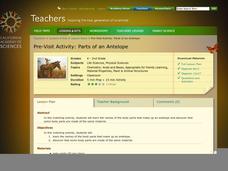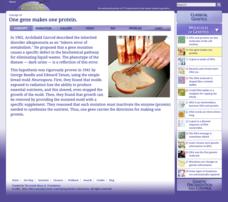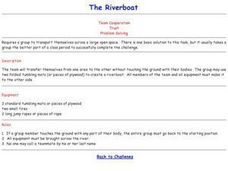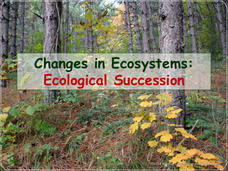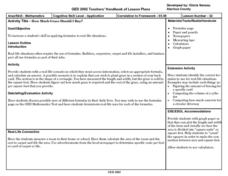Curated OER
The Web of Life
Students demonstrate the interrelationships of animals and plants. In this ecology lesson, students discuss the things plants and animals need for survival and study the glacier food chain. Students simulate the web of life by using a...
California Academy of Science
Parts of an Antelope
There are so many wonderful parts to an animal: fur, antlers, tails, and legs, to name a few. A large diagram of an antelope is used to start a matching game, where the class matches body parts made of the same material. They discuss...
Association of Fish and Wildlife Agencies
Schoolyard Biodiversity Investigation Educator Guide
In 1980, in the tropical rainforests of Panama, scientists discovered 1,200 species of beetles living in and around just 19 trees, with most of the species new to science—that's biodiversity! In the activity, learners work in teams to...
Curated OER
Reading Comprehension 6: Level 9
Did you know that an acre of trees can absorb as much carbon dioxide as a car emits in 11,000 miles of driving? Such fun facts abound in a short reading comprehension passage detailing the benefits of parks and rooftop gardens. After...
Khan Academy
Challenge: A Loopy Landscape
Drawing trees and grass over and over again is the perfect time to add a while loop to your computer code. This activity guides coders through the steps as they practice using this loop.
Cold Spring Harbor Laboratory
One Gene Makes One Protein
Very few universities still offer a master's degree in the ecology of grasses, but that was the degree that led George Wells Beadle to an interest in genetics and later a Nobel Prize. Scholars learn about the discoveries of Dr. Beadle...
Curated OER
10 P.E. Lesson Plans for Track and Field
Ten lesson plans for track and field include safety tips and class activities. The class activities include basic teaching instructions on how to perform each skill. There are some diagrams included to help you see what to do. Use this...
Curated OER
Go To Sleep, Gecko!
Second graders examine the interdependence of organisms using the book "Go To Sleep, Gecko!" They examine a variety of food chains, listen to the book, and answer story comprehension questions. Students then conduct research on food...
Curated OER
The Riverboat
Get a boat across the river! Work on problem-solving with tumbling mats to represent the boat, and try to get a crew across the grass without any of the members touching the ground. This will take team work, cooperation, and...
Curated OER
Fun Faces of Wisconsin Agriculture: Curley's Beef Fast Facts
Students explore animal slaughter by researching the Wisconsin beef industry. In this meat statistics instructional activity, students practice using different math functions to identify how many burgers or sports equipment can be made...
Curated OER
Who Wants to be a Millionaire: Ancient Egypt Edition
"Who Wants to be a Millionaire" is a fun game to play and a great way to review any topic. Use this game to test content knowledge related to Ancient Egypt. Egyptian gods, structures, alphabet, and lifestyles are all tested.
Curated OER
The Direct Object
What exactly is a direct object? Use this resource to introduce direct objects to your middle and early high school classrooms. The section at the top explains the part of speech, and then there are 20 sentences below for learners to...
McGraw Hill
Determine the Meaning of Words and Phrases
Work on using context clues in your social studies class. Pupils read a brief selection about the terrain in Senegal and define each of the underlined words in the space provided. They also list the context clues that helped them...
Wordpress
Darwin’s Natural Selection Case Studies
This editable worksheet is set up so that biology pupils read four case studies and identify points that are present in each, such as overproduction, heritable variation, struggle to survive, and differential reproduction. They also...
Biology Junction
Changes in Ecosystems: Ecological Succession
Can an area with no soil turn into a forest? Scholars learn about the process of ecological succession using an interesting presentation. It covers both primary and secondary succession in the building of new ecosystems.
Curated OER
Very, Very, Simple Decorative Papers
Elementary schoolers gather flowers, leaves, fiber, ribbons and newspapers to expand studenT awareness of their environment. They use these to make printmaking papers, cards, book covers, picture frames and photo mats. Beautiful results...
Curated OER
Understanding the Poem
Practice literary analysis with your poetry pupils using the mysterious narrative poem "The Listeners." They examine the archaic language and answer 12 comprehension and analysis prompts. Foster creativity with these referential...
Curated OER
Plants have needs, too!
Plants can die if they don't get enough sunlight and water. Kindergartners observe a picture of a hanging plant and grass under a tree, and interpret which each plant has died. Next, they grow watercress seeds in wet cotton to compare...
Curated OER
Eggshell People
Students observe grass growth. In this agricultural lesson, students use empty eggshells and fill them with soil and grass seed. Students record eggshell "hair growth" on a chart.
Curated OER
Conserving Resources by Watering Efficiently
Students determine a watering schedule that promotes healthy grass growth. For this plants and natural resource conservation lesson, students plant grass seed in liter bottles and follow two different schedules that include "more...
Curated OER
Soil Erosion Demonstrations
Students conduct experiments demonstrating soil erosion and the benefits of conservation practices. Working in groups, they use topsoil and sand in shallow boxes as models to examine the effects of water on soil and sand with and without...
Curated OER
Computation: How can we use rice to solve problem questions?
Fourth graders graph metric tons of rice produced by various countries. In this graphing instructional activity, 4th graders follow problem solving steps to answer questions about rice nutrition and then graph the amount of rice...
Curated OER
Using Abiotic and Biotic Parameters to Monitor Air Quality
Students identify the abiotic factors that influence a river or stream and the organisms that live in it. They measure several abiotic and biotic parameters to gauge water quality. Students examine the biotic environment by identifying...
Curated OER
How Much Grass Should I Buy?
Students examine a variety of real life situations in which they must access information, select an appropriate formula, and calculate an answer. A rectangular piece of grass provides an opportunity for the exploration of this lesson.

